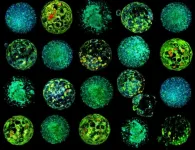(Press-News.org) Chicago (July 1, 2024) — What does whole wheat have that refined flour lacks? A new study reveals key differences in nutrient content along with exactly where nutrients are lost — and sometimes gained — along the journey from farm to table.
While previous studies have assessed the nutrients contained in various crops or in food products, the new study is among the first to bridge the two by tracing how processing and baking influence nutrient composition at each step.
Researchers report that levels of major minerals were cut by nearly three-quarters in refined flour and breads made with refined flour compared with whole wheat. Additionally, milling and baking markedly reduced the amount of other nutrients, such as vitamin E, in both refined and whole wheat products compared with raw wheat kernels.
“Tracking nutrient content from farm to table is key for appraising what agricultural products actually contribute to the diet,” said David Killilea, PhD, a researcher at the University of California San Francisco. “Our experimental approach revealed that both milling and baking had significant impacts on multiple nutrient levels within wheat flour and bread.”
Killilea will present the findings at NUTRITION 2024, the flagship annual meeting of the American Society for Nutrition held June 29–July 2 in Chicago.
The Dietary Guidelines for Americans recommend that whole grains constitute at least half of the total grains we consume, but research shows that most people do not meet this recommendation. By revealing the stark differences in nutritional value between more refined and less refined wheat products, the study underscores the importance of a diet rich in whole grains.
“Whole grains have an important role to play in the nutritional palette of the Western diet, and we strongly support the promotion of whole grain consumption,” said Killilea. “Processes that enrich the nutrient density of wheat-based foods should be encouraged, while processes that deplete nutrient density should be understood.”
For the study, researchers obtained raw wheat kernels from a single farm source, milled the kernels to produce three different types of flour and then used the flours to prepare breads. They assessed the levels of major minerals (calcium, magnesium, phosphorous, potassium), trace minerals (copper, iron, molybdenum, zinc), carotenoids (vitamin A-like compounds) and vitamin E at each step.
The three flour types were intact whole wheat flour (produced by stone-milling), reconstituted whole wheat flour (produced by roller-milling) and refined white flour (produced by roller milling with bran and germ removed).
In the two types of whole wheat flours, levels of major minerals remained virtually unchanged from kernel to flour to bread, while the levels of some trace minerals actually increased during processing. In refined flours and breads, major minerals were reduced by up to 72% and trace minerals were reduced by up to 64% compared with wheat kernels.
Vitamin E levels dropped substantially with each processing step, regardless of the type of flour used to prepare the breads. Ultimately, breads made with all flour types contained less than one-fifth the amount of vitamin E as wheat kernels. Levels of carotenoids were also reduced when the flours were baked into breads, with all breads containing less than one-quarter the amount of carotenoids as wheat kernels.
Next, the researchers plan to study how different farming or processing practices could influence the nutrient density of wheat and wheat products. Since inadequacies of vitamins A and E are a significant health concern in the U.S., they plan to focus particularly on whether fermentation or other processes could help to preserve the vitamin content of wheat products.
Killilea will present this research at 2:12-2:24 p.m. CDT on Monday, July 1, during the Food Science and Nutrition session in McCormick Place (abstract; presentation details).
Please note that abstracts presented at NUTRITION 2024 were evaluated and selected by a committee of experts but have not generally undergone the same peer review process required for publication in a scientific journal. As such, the findings presented should be considered preliminary until a peer-reviewed publication is available.
About NUTRITION 2024
NUTRITION 2024 is the flagship meeting of the American Society for Nutrition and the premier educational event for nutritional professionals around the globe. NUTRITION brings together lab scientists, practicing clinicians, population health researchers, and community intervention investigators to identify solutions to today’s greatest nutrition challenges. Our audience also includes rising leaders in the field – undergraduate, graduate, and medical students. NUTRITION 2024 will be held June 29–July 2, 2024 in Chicago. https://nutrition.org/N24 #Nutrition2024
About the American Society for Nutrition (ASN)
ASN is the preeminent professional organization for nutrition research scientists and clinicians around the world. Founded in 1928, the society brings together the top nutrition researchers, medical practitioners, policy makers and industry leaders to advance our knowledge and application of nutrition. ASN publishes four peer-reviewed journals and provides education and professional development opportunities to advance nutrition research, practice, and education. Since 2018, the American Society of Nutrition has presented NUTRITION, the leading global annual meeting for nutrition professionals. http://www.nutrition.org
Find more news briefs from NUTRITION 2024 at: https://www.eurekalert.org/newsroom/nutrition2024/home.
###
END
A new technology developed by the "Bioengineering in Reproductive Health" team at the Institute for Bioengineering of Catalonia (IBEC) is able to visualise the metabolism of embryos obtained through in vitro fertilisation in order to decide which are most likely to implant correctly in the uterus and reaching full-term. It is a more accurate and reliable technique than traditional methods.
The revolutionary method, called METAPHOR", generates 3D images that reveal the colours present in the embryo in a completely non-invasive way. Certain naturally fluorescent compounds in the embryo's metabolism are also key to processes such as cellular respiration ...
Melting Arctic glaciers are in rapid recession, and microscopic organisms colonise the newly exposed landscapes. Dr. James Bradley, Honorary Reader in Arctic Biogeochemistry in the School of Biological and Behavioural Sciences at Queen Mary University of London, and his team, have revealed that yeasts play an important role in soil formation in the Arctic after glaciers have melted away.
Roughly 10% of Earth’s land surface is covered by glacial ice. However, glaciers are retreating ever further and ever faster because of global warming. As they do, ...
EMBARGOED UNTIL JULY 1, 2024 AT 3:00 PM U.S. EASTERN TIME
According to a new study published in the Proceedings of the National Academy of Sciences, extensive land areas have been left sitting idle after tropical forests were cleared in Indonesia, a country renowned for its biodiverse rainforests and carbon-rich peatlands. Since 1990, the country has lost 25% of its old-growth forest, and while over one-quarter (7.8 million hectares) of Indonesia’s deforested lands have been converted to palm oil plantations since ...
University of Cincinnati researchers have pioneered an animal model that sheds light on the role an understudied organ in the brain has in repairing damage caused by stroke.
The research, published July 5 in the Proceedings of the National Academy of Sciences, sought to learn more about how the adult brain generates new neurons to repair damaged tissue.
The research team focused on the choroid plexus, a small organ within brain ventricles that produces the brain’s cerebrospinal fluid (CSF). CSF circulates throughout the brain, carrying signaling molecules and other factors thought to be important for maintaining brain function. However, prior to this study, little ...
Smoking continues to rank as the foremost preventable cause of premature death. In a paper published this week in the Proceedings of the National Academy of Science (PNAS), Harvard researchers report findings that evoking feelings of gratitude in people who smoke helps reduce their urge to smoke, and increases their likelihood of enrollment in a smoking cessation program. They note that these findings could inform newer approaches to public health messaging campaigns that aim to reduce so-called “appetitive” risk behaviors like smoking, drinking, and drug use.
The research team built on the Appraisal Tendency Framework, a theoretical model of emotiona and decision making, ...
The COVID-19 pandemic had an unprecedented effect on college students’ mental health: symptoms like anxiety and major depression in young adults ages 18-25 increased significantly compared to before the pandemic.
A new study from researchers at the University of North Carolina at Chapel Hill looks at a possible contributing factor to the worsening trends in mental health: social media.
We know that college students and adolescents are using social media more. Last May, the US Surgeon General issued an advisory on social media and youth mental ...
WASHINGTON, D.C., July 1, 2024 — The latest issues of four American Psychiatric Association journals, The American Journal of Psychiatry, Psychiatric Services, American Journal of Psychotherapy and Psychiatric Research and Clinical Practice are now available online.
The July issue of The American Journal of Psychiatry brings together research on affective disorders, pharmacogenomics, and psychiatric illness-related cardiometabolic problems. Highlights include:
• Genome-Wide Association Study of Treatment-Resistant Depression: Shared Biology With Metabolic Traits.
• Pharmacogenomic Clinical ...
The most climate-vulnerable countries with the highest hunger rates are significantly under-represented in agrifood research – sparking a need for urgent action and increased investments to redress this imbalance, a major new study has found.
The ‘State of the Field for Research on Agrifood Systems’ report, published by The Juno Evidence Alliance – a partnership of CABI, Havos.Ai and the University of Notre Dame, USA – found that only one out of eight research papers is led by scientists from ...
A team led by University of Maryland computer scientists invented a camera mechanism that improves how robots see and react to the world around them. Inspired by how the human eye works, their innovative camera system mimics the tiny involuntary movements used by the eye to maintain clear and stable vision over time. The team’s prototyping and testing of the camera—called the Artificial Microsaccade-Enhanced Event Camera (AMI-EV)—was detailed in a paper published in the journal Science Robotics in May 2024.
“Event cameras are a relatively new technology better at tracking ...
UNIVERSITY PARK, Pa. — To advance soft robotics, skin-integrated electronics and biomedical devices, researchers at Penn State have developed a 3D-printed material that is soft and stretchable — traits needed for matching the properties of tissues and organs — and that self-assembles. Their approach employs a process that eliminates many drawbacks of previous fabrication methods, such as less conductivity or device failure, the team said.
They published their results in Advanced Materials.
“People have been developing soft and stretchable conductors for almost a decade, but the conductivity ...








